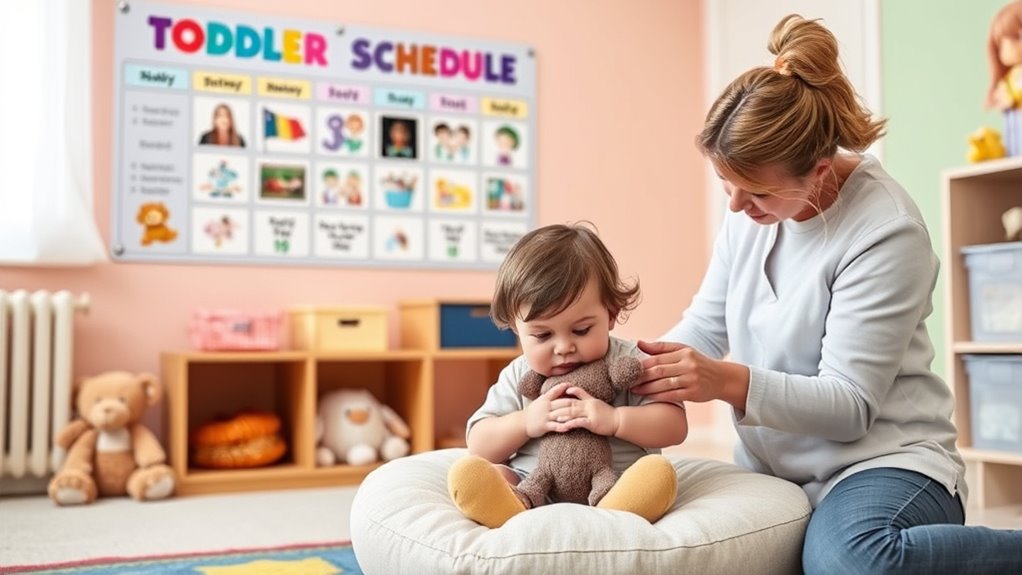To handle toddler tantrums effectively, look for early signs like clenched fists or avoidance. Create a calm environment with soft lighting, sensory zones, and comforting items. Use breathing exercises, distraction with favorite songs or sensory toys, and safe fidget tools to soothe your child. Establish clear routines and model calm behavior, which helps your toddler feel secure. Supporting emotional expression through art and play can also prevent future outbursts. Discover more tools and tips that work perfectly when you continue exploring.
Key Takeaways
- Recognize early emotional cues and create a calm environment with soft lighting and sensory zones.
- Use deep breathing and distraction techniques like singing or sensory toys to soothe a upset toddler.
- Employ visual aids and model calm behavior to promote understanding and emotional regulation.
- Establish consistent routines and clear boundaries to reduce frustration and prevent tantrums.
- Support emotional expression through art, storytelling, and safe outlets to help toddlers process feelings effectively.
Recognizing Early Signs of a Tantrum

Recognizing the early signs of a tantrum can help you intervene before it escalates. Pay close attention to emotional cues your toddler shows, such as clenched fists, furrowed brows, or a tense posture. These early warning signs often indicate frustration or overwhelm building up. You might notice your child becoming more clingy, whining, or avoiding eye contact. These subtle cues can signal that a tantrum is brewing, giving you a chance to respond calmly. Acting early helps prevent the situation from spiraling out of control, making it easier to manage your child’s feelings and foster a sense of security. Understanding behavioral cues can be crucial in effectively handling tantrums. Recognizing these signs is key to handling tantrums effectively, especially when combined with emotional awareness to better address your child’s needs. Additionally, cultivating vibrational energy through calmness and positivity can influence your child’s emotional state and help de-escalate the situation.
Creating a Calm Environment

You can help prevent tantrums by creating a calm environment for your toddler. Use soft lighting and quiet play areas to reduce overstimulation, making it easier for them to feel secure. Adding calming background sounds can also help soothe your child and promote a peaceful atmosphere. Incorporating comfort and support solutions into their routine can further promote relaxation and emotional security.
Soft Lighting Choices
Soft lighting plays a crucial role in creating a calming environment that can help soothe a toddler during a tantrum. Using dim lighting and warm hues creates a cozy, secure space that signals comfort and safety. Avoid harsh overhead lights, and opt for lamps or string lights that emit gentle, warm glow. This subtle illumination reduces overstimulation and encourages relaxation. Consider the table below to choose the right lighting options:
| Lighting Type | Effect | Best Use |
|---|---|---|
| Dim lamps with warm hues | Softens the room’s atmosphere | Evening calming routines |
| Fairy lights | Creates a cozy ambiance | Gentle background lighting |
| Nightlights | Provides reassurance | During quiet time or bedtime |
Additionally, selecting appropriate lighting can help set a tranquil mood conducive to calming down, which aligns with creating a calm environment that supports emotional regulation during tantrums. Incorporating lighting that minimizes stimuli can further enhance the soothing effect.
Quiet Play Areas
Creating a designated quiet play area provides a peaceful retreat where toddlers can regain composure and relax. These quiet play areas serve as sensory zones, helping your child self-regulate during overwhelming moments. Fill the space with soft, inviting materials like plush cushions, calming toys, and textured objects that engage their senses without overstimulating. Keep the environment clutter-free and soothing, using gentle colors and minimal noise. This calm corner offers a safe haven for your toddler to wind down and gather their emotions. Incorporating sensory zones in your home creates a consistent, comforting space that encourages self-soothing. Research shows that divorce statistics highlight the importance of creating secure environments, which can also be beneficial in managing toddler tantrums. When tantrums occur, guiding your child to their quiet play area helps them regain control and feel secure, making it an essential tool in managing challenging moments.
Calming Background Sounds
Introducing calming background sounds into your home can considerably help soothe a distressed toddler. These sounds create a peaceful environment that encourages relaxation. Consider trying these options:
- Nature sounds, like gentle rain or ocean waves, can evoke calmness and reduce stress.
- White noise, such as a fan or specialized machine, masks disruptive noises and promotes focus.
- Soft instrumental music can provide a soothing backdrop without overstimulating.
- Calm ambient sounds, like wind rustling or distant thunder, help create a serene space.
Using these background sounds consistently can signal to your toddler that it’s time to relax, making tantrum management easier. Incorporate them during quiet times or transitions to foster a calm, safe environment.
Using Breathing Exercises to Soothe Your Child

When your child is overwhelmed by a tantrum, guiding them to focus on their breath can be remarkably calming. Encourage them to take slow, deep breaths, helping to regulate their emotions. You can teach them to inhale deeply through their nose, filling their lungs, then exhale slowly through their mouth. To make it engaging, have them count their breaths, such as “breathe in, one, two, three,” then “breathe out, one, two, three.” This simple counting helps redirect their focus away from the tantrum and toward calming themselves. Deep breathing triggers relaxation, reducing distress and helping your child regain control. Practice this technique consistently, so it becomes a familiar tool they can use anytime they feel overwhelmed.
Incorporating Safe and Engaging Fidget Tools

Using safe and engaging fidget tools can be an effective way to help your child manage their emotions during a tantrum. These tools, like sensory bins and calming fidget toys, provide sensory input that calms the nervous system and redirects their focus. Here are some ideas to incorporate:
- Sensory bins filled with rice, beans, or water beads to engage their senses.
- Soft, squishy calming fidget toys for tactile comfort.
- Textured fabrics or silicone rings for handheld stimulation.
- Small, portable sensory tools that can be easily carried and used anytime.
- Incorporating sensory input into your child’s routine can also support their overall emotional development and resilience. Being mindful of age-appropriate options ensures safety and effectiveness for your child’s specific needs.
These resources help your child self-soothe and regain control without overwhelming them. Keep safety in mind, ensuring all items are non-toxic and age-appropriate. Additionally, understanding how sensory input influences emotional regulation can enhance your approach to managing tantrums effectively.
Employing Distraction Techniques Effectively

Distraction techniques can be powerful tools to redirect your toddler’s attention away from a tantrum and toward a more positive focus. Music therapy is especially effective; singing a favorite song or introducing a lively tune can shift their mood instantly. Sensory activities also work well—offer textured toys, bubbles, or a sensory bin to engage their senses. These activities divert their focus and help calm their emotions. Keep a few go-to distractions handy for quick responses. When a tantrum begins, gently introduce the distraction, ensuring it’s engaging enough to capture their interest. Incorporating sensory engagement like noise makers or visual stimuli can further enhance these techniques. Regularly practicing these methods can help your child develop self-regulation skills and promote emotional resilience over time. Additionally, understanding that behavior management strategies rooted in consistency and patience can reinforce calming techniques is essential for long-term success.
Implementing Visual Schedules and Calm-Down Corners

Implementing visual schedules and calm-down corners provides clear structure and a designated space for your toddler to regain control during emotional moments. A visual schedule benefits both you and your child by offering predictability and reducing frustration. Setting up a calm down corner creates a safe environment where your toddler can self-regulate. Here’s how to do it effectively:
- Choose a quiet, cozy spot with minimal distractions.
- Use pictures or simple words to illustrate daily routines and calming activities.
- Stock the calm down corner with soft toys, calming music, or sensory tools.
- Regularly review and update the visual schedule to match your child’s development.
- Incorporate recycled materials into your setup to promote sustainability and add unique, eco-friendly elements to the calming space. Incorporating community resources or local eco-friendly suppliers can help you find sustainable materials for your setup. Utilizing cost-effective production methods for your materials can also help manage expenses while maintaining quality.
This setup helps your toddler understand expectations and develop self-soothing skills, making tantrum management smoother.
Modeling Calm Behavior for Your Toddler

Modeling calm behavior is one of the most effective ways to teach your toddler how to manage their emotions. When you stay composed, you show patience and demonstrate empathy, encouraging your child to do the same. Your reactions set a powerful example, especially during tantrums. For instance, if your child throws a toy, respond calmly and avoid anger. This helps them understand emotional regulation through your actions. Here’s a visual to illustrate:
| Your Calm Response | Your Toddler’s Behavior |
|---|---|
| Take deep breaths, speak softly | Begins to mirror your calmness |
| Show understanding with gentle words | Learns empathy and patience |
| Maintain steady eye contact | Feels safe and understood |
| Offer comfort without judgment | Builds trust and emotional resilience |
Additionally, consistent sleep routines and a secure environment can significantly reduce tantrum frequency and intensity.
Establishing Consistent Routines and Boundaries

Consistent routines and clear boundaries help your toddler feel secure and understand what to expect each day. When you set boundaries, you’re providing structure that reduces confusion and frustration. Here are four key ways to establish effective routines and boundaries:
- Stick to regular wake-up and bedtimes to create predictability.
- Use simple, clear rules to set boundaries, like “No hitting” or “Keep hands to yourself.”
- Incorporate consistent mealtime and playtime schedules to build daily rhythm.
- Enforce boundaries calmly and consistently, reinforcing expectations without anger or frustration.
Encouraging Emotional Expression Through Art and Play

Encouraging your toddler to express their emotions through art and play helps them understand and communicate their feelings more effectively. Providing opportunities for colorful art allows your child to visually express complex emotions, making it easier for them to process feelings like frustration or joy. Incorporate creative storytelling by encouraging your toddler to narrate stories about their artwork or pretend scenarios. This practice boosts their emotional vocabulary and helps them identify and articulate their experiences. Engaging in these activities fosters a safe space for emotional exploration, reducing tantrums caused by overwhelmed feelings. By supporting their creative outlets, you empower your toddler to share their inner world confidently, laying a foundation for healthier emotional regulation as they grow.
Frequently Asked Questions
How Can I Prevent Tantrums Before They Start?
To prevent tantrums before they start, use preventative strategies like setting clear routines and offering choices to give your child a sense of control. Pay attention to emotional awareness, noticing signs of frustration or tiredness early. By addressing these cues promptly, you can reduce triggers. Keep calm, stay consistent, and communicate positively. This proactive approach helps your toddler feel secure, minimizing the chances of a tantrum erupting.
What Are Signs My Toddler Is Overwhelmed or Overstimulated?
Your toddler’s tiny world can sometimes feel like a rollercoaster. Watch for warning signs like clenched fists, furrowed brows, or fussiness—that’s their overstimulation cues. If they start to cover their ears or cling tightly, it’s a red flag. Recognizing these signs early helps you step in before a meltdown, giving your little one space to breathe and reset, turning chaos into calm.
How Do I Handle Tantrums in Public Places Discreetly?
When your toddler tantrums in public, stay calm and discreet. Use distraction techniques like pointing out interesting sights or offering a favorite toy. Sensory tools such as a soft cloth or stress ball can help soothe them quietly. Gently guide your child to a quieter space if possible, and speak softly. Remember, your calm presence reassures your toddler and helps de-escalate the tantrum without drawing unnecessary attention.
When Should I Seek Professional Help for Frequent Tantrums?
You should seek professional help when tantrums become frequent, intense, or persist beyond typical age-appropriate behaviors and developmental milestones. If your child’s outbursts interrupt daily routines, cause harm, or seem disproportionate to their age, it’s time to consult a specialist. Recognizing these signs helps you address underlying issues early, ensuring your child’s emotional and developmental needs are met, and guiding them toward healthier ways to express their feelings.
How Can I Involve My Child in Calming Routines?
You can involve your child in calming routines by making them fun and consistent. Use positive reinforcement to praise their cooperation, like saying, “Great job calming down!” Keep routines predictable so your child knows what to expect, which helps them feel secure. Encourage participation by letting them choose a calming activity, like a favorite stuffed animal or a calming song, reinforcing positive behavior and creating a sense of control.
Conclusion
Remember, your calm response can markedly reduce tantrums—studies show that children who feel understood are 50% less likely to escalate. By recognizing early signs, creating a soothing environment, and modeling calmness, you help your toddler learn emotional regulation. Incorporate tools like fidget toys and distraction techniques to keep them engaged. With patience and consistency, you’ll build a stronger bond and foster your child’s emotional growth, making challenging moments easier for both of you.









